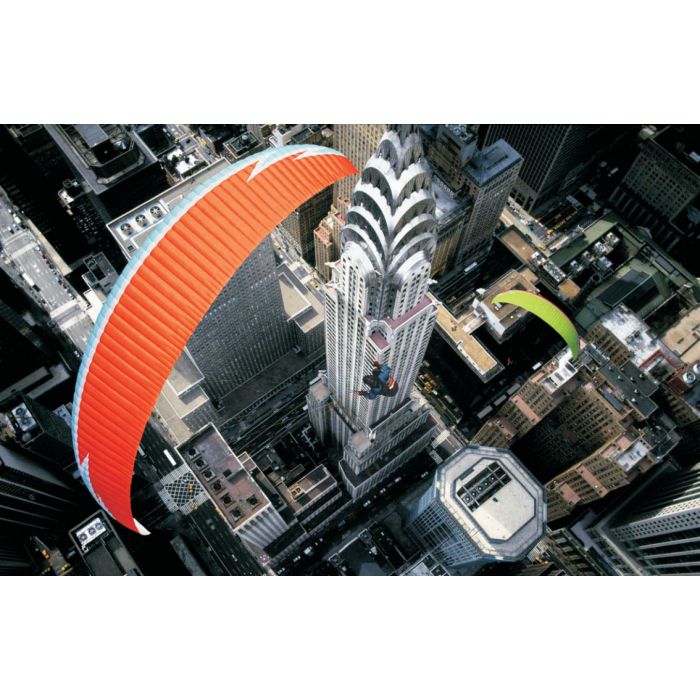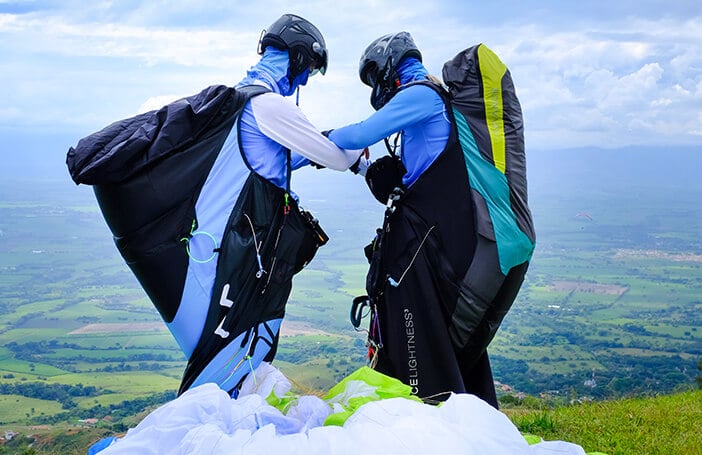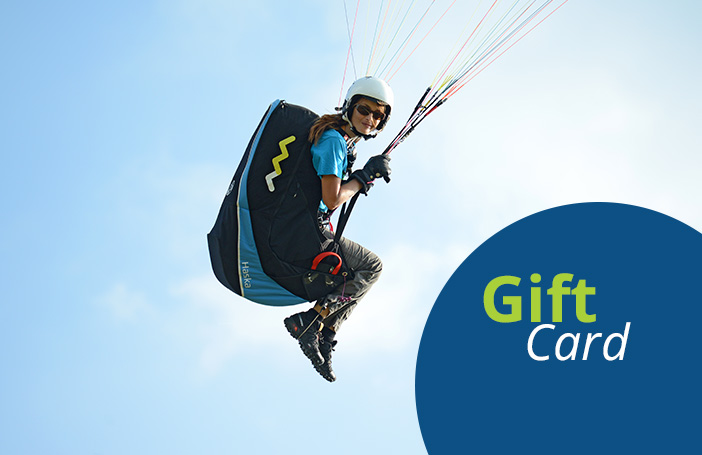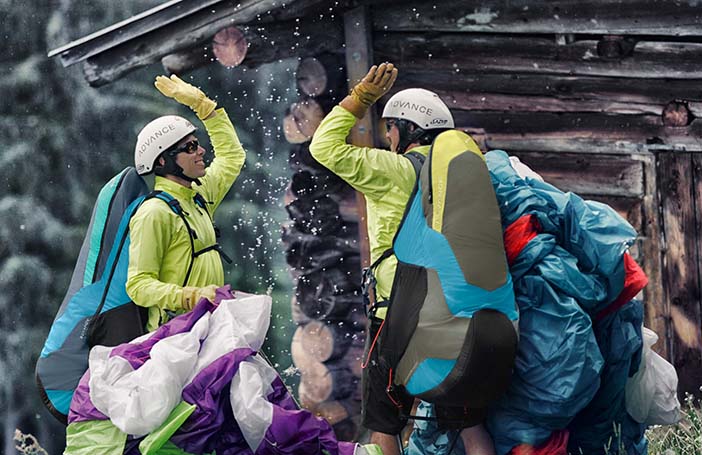
Nova Factor 2 (PAST MODEL)
Select all options to view stock availability

It's hard to stop our enthusiasm about the Factor 2. The fun starts with the sorting the lines - minimum effort: including stability and brake line there are only 8 lines! The launch itself, very simple, the canopy will quickly come up without any tendency to dash forward and the retraction speed is low. No wonder with this performance! 3 tenth of better glide ration than the Mentor 2, that says everything. The class leader Factor 2 will prolong the Mentor 2 success.
Special emphasis has put our development team on the handling of the Factor 2. It is even smoother and more precise than the Factor 1, this is something we are particularly proud of. The optimized accelerator gives the pilot a lot of speed increase while pushing only a short way on the speed bar - this feature complete our new Factor 2 and we're sure you will be amazed!
Development
After finishing the Mentor 2 we started to design a glider for the EN C class: The Factor 2. Compared to the Mentor 2 we wanted more dynamic and even more precise handling characteristics. Further more we were aiming for a significantly higher glide ratio and for more top speed.
It took us more than half a year to combine all those characteristics in one glider. We needed a couple of more weeks in strong thermal conditions for fine tuning the glider and to finally test the pre-serial wings
During the design process we could use a lot of the knowledge that we had gathered from the Mentor 2. From the technical point of view the Factor 2 is kind of the “big brother” of the Mentor 2.
Flying the Factor 2
If you liked the agile handling characteristics of the Factor 1, you will immediately feel comfortable with the Factor 2. The glider reacts to steering inputs very precisely and with little delay. The brake travel which is needed to fly the glider efficiently in thermals is now even less than with the Factor 1.
Furthermore we could increase the stability in turbulences: Collapses are very rare with the Factor 2, no matter if flying accelerated or at trim speed. The directional stability is also greater, which is a big help for flying through turbulences at high speed.
The top speed is significantly higher than on the Factor 1 and it’s very comfortable to use the accelerator due to the smooth-running speed system and the rather small operating travel.
Altogether we have been able to increase the XC-potential as well as the “Fun Factor”, which is well known among all Factor 1 pilots.
Safety
The final stages of the development process took place during spring and summer. This means, we had very strong thermals and strong valley winds in our test area at the Achen-Lake. Test flights in such conditions are indispensable for us, because they provide more information about a gliders safety than just flying test manoeuvres in calm air.
In turbulent conditions the Factor 2 stands out with a very high stability and it retains this stability up to the top speed. Big collapses are very rare. If the wing collapses, the reopening is rather damped and without impulsiveness.
Overall the Factor 2 offers a very reliable and easily manageable behaviour for the target-group of experienced pilots.
Performance
We have never been able to increase the performance between two product generations as much as from Factor 1 to Factor 2; the Factor 2 clearly outperforms its “smaller brother”, the Mentor 2.
The top speed is also a lot higher than on the Mentor 2. Both wings have outstanding stability and a flat polar in common.
All those things considered, the Factor 2 offers unique possibilities for XC-pilots.
Technical changes compared to Factor 1
- New airfoil: because of the three line levels, we needed a new airfoil. It stands out for its pitch stability, and a high collapse resistance.
- Mini-ribs at the trailing edge: These ribs help to increase the surface finish and thereby increase the performance.
- New suspension: The Factor 2 has just three suspension levels and less attachment points at each line level. This leads to a significantly reduced drag.
- Integrated polyamide rods: These very sturdy rods replace the mylar reinforcements and lead to less weight and more stability. The rods don’t need any more care than the mylar reinforcements did.
- Reef system on the trailing edge: To improve the handling characteristics (e.g. to reduce the brake pressure) we have reef bands on the trailing edge which distribute the suspension load.
Pilot's profile
The FACTOR 2 is a High Performance glider, which offers a very precise and dynamic handling behaviour. We only recommend the glider for pilots who are very well in control of certain techniques, like controlling a glider in turbulent conditions:
The pilot should be able to prevent unwanted pitch or roll movement in bumpy air automaticly. If the pilot enters a strong thermal, he should intuitionally release the brakes to stop the glider from pitching backwards. When flying into sinking air, the pilot should apply more brakes.
The FACTOR 2 pilot should also be able to easily fly steep turns without unwanted pendulum movement. We think, that a pilot, who is not capable of those basic techniques will not be able to use the huge performance potential of the FACTOR 2.
Furthermore the pilot should have a feeling for the available brake travel and for an oncoming stall or for a spin. In such a case the pilot has to react properly and quickly.
To react quickly and without thinking is also necessary after collapses. We think, that this can only be achieved by training, which means by inducing collapses. (for example by attending a SIV) Training can also mean to spend some time on a training hill to work on your ground handling and take-off technique.
All this will help you, to get a better understanding of your glider and to become a better pilot.
Every pilot, who flies on their own has to be able to decide if their skills and equipment is adequate for the respective conditions. The FACTOR 2 offers a high level of safety for a pilot with proper skills, but misjudgements may still have serious consequences.
The best way to avoid misjudgements is a defensive approach to the sport. Some times it makes sense to pass on a flight, instead of getting yourself into conditions you cannot handle. Regular training improves your skills and enables you to enjoy your flights, even in more difficult conditions.
If you don’t meet the requirements for such a glider, you won’t be able to use the potential of the FACTOR 2. You will fly longer, further, safer and with more joy with a lower rated wing, like the MENTOR 2 for example.
Please consider these thoughts!
Technical Data
Type |
- |
XS |
S |
M |
L |
| Zoom factor | - | 0.910 | 0.960 | 1.000 | 1.040 |
| No of cells | - | 63 | 63 | 63 | 63 |
| Projected wingspan | m | 8.78 | 9.27 | 9.65 | 10.09 |
| Projected surface area | m² | 18.20 | 20.30 | 22.00 | 24.10 |
| Projected aspect ratio | - | 4.23 | 4.23 | 4.23 | 4.23 |
| Flat wingspan | m | 11.47 | 12.10 | 12.61 | 13.17 |
| Flat surface area | m² | 21.83 | 24.30 | 26.36 | 28.79 |
| Flat aspect ratio | - | 6.03 | 6.03 | 6.03 | 6.03 |
| Line diameter | mm | 0,6 / 0,7 / 0,8 / 1,1 / 1,3 / 1,7 | 0,6 / 0,7 / 0,8 / 1,1 / 1,3 / 1,7 | 0,6 / 0,7 / 0,8 / 1,1 / 1,3 / 1,7 | 0,6 / 0,7 / 0,8 / 1,1 / 1,3 / 1,7 |
| Line length | m | 6.64 | 7.01 | 7.30 | 7.63 |
| Line consumption | m | 233 | 246 | 256 | 268 |
| max. profile depth | m | 2.38 | 2.52 | 2.62 | 2.74 |
| min. profile depth | m | 0.60 | 0.64 | 0.66 | 0.69 |
| Weight | kg | 5.8 | 6.1 | 6.4 | 6.7 |
| Legal take-off weight | kg | 65-90 | 80-100 | 90-110 | 100-130 |
| take-off weight motor | kg | ||||
| Places | - | 1 | 1 | 1 | 1 |
| Certification | - | (C) | C | C | (C) |
Colours
Standard Colours: Green Fizz; Blue Wind; Red Banana; Orange Flux.
Custom Colours: Choose your colours here then email us the NOVA colour code with your order.
| Condition | New |
|---|---|
| EN Certification | EN C |
| LTF Certification | LTF C |
| Model Status | Past model |
Standard UK delivery - £3.95 / FREE on orders over £100.
Outside the UK - delivery calculated at checkout (based on the total order value and your delivery address).
We use Royal Mail, Parcelforce Worldwide and other courier companies (e.g. DHL, DPD) depending on shipment value, weight, destination etc.
For more information, please view our order and delivery FAQs page.
If you are not 100% satisfied with your order, you have 14 days from the day of delivery to request a refund.
Delivery costs will not be refunded and you will be responsible for the delivery cost to return the order.
For more information, please read our returns and exchanges policy.



